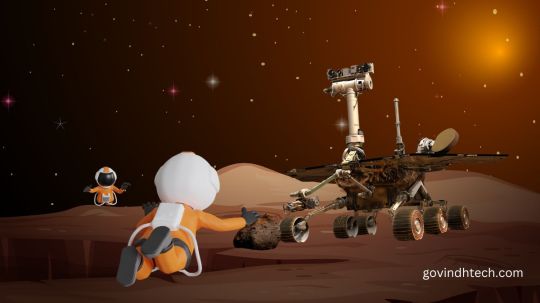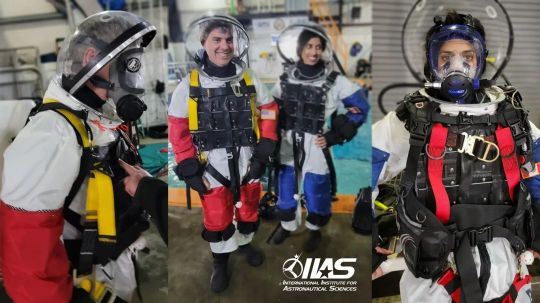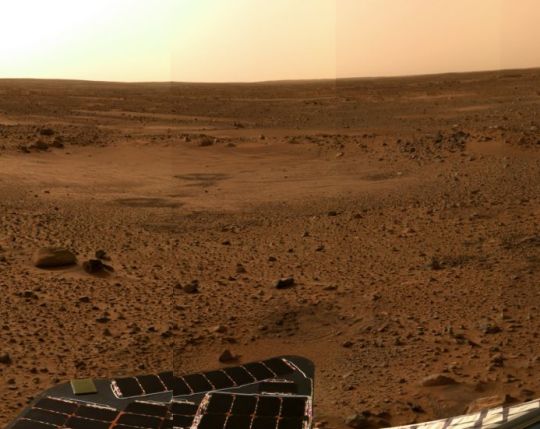#MarsExploration
Text

July 14, 1965, a groundbreaking mission that paved the way for exploring the Red Planet was carried out. Mariner 4 was the first to get valuable data and images that revolutionized our knowledge of our neighboring planet.
Mariner 4, a probe developed by NASA, went on a daring journey to explore Mars. She traveled for nearly seven months before arriving at her destination, covering a distance of about 325 million kilometers. This mission marked the first time humanity could take a closer look at the mysterious landscape of Mars.
As Mariner 4 approached Mars, it took a series of images, revealing a world never before seen. The images sent back to Earth have revealed a lush, crater surface, and challenged previous hairs about a more Earth-like environment. The images have provided us with our first glimpse of the Mars landscape.
Mariner 4's Mets also provided essential scientific data on Mars' atmosphere and temperature. It identified a thin atmosphere consisting mainly of carbon dioxide, and paved the way for future missions to explore the Earth's climate and life potential. The success of the mission was no less than a celebration in the space world and the whole world.
SpaceIL
#MarsExploration#SpaceMission#MartianLandscape#AstroFacts#RedPlanet#SpaceDiscovery#CosmicJourney#UnravelingMars#Inspirationstartshere#mariner#amazing#nasa#spaceil#moonlight#moonbin
14 notes
·
View notes
Text
Space Tech: Private Ventures and Mars Exploration

Space Tech
Beyond intrepid exploration, space technology has advanced to address pressing issues on Earth. It is becoming more and more essential to the effective operation of contemporary societies and their economic growth. Space has the potential to directly affect billions of people’s lives and open up large-scale, highly impactful solutions.
A broad term for satellites, space stations, ground stations, tracking and monitoring centers, downstream analytics and artificial intelligence, software, and other technologies, SpaceTech offers innovative ways to solve global concerns. Satellites increase communication, navigation, and earth observation capacity at low cost even in remote locations. Satellite-based earth observation data is vital, accurate, and reliable for data-driven decision-making by businesses and governments.
The underserved and otherwise unprofitable regions can benefit from high-speed connectivity thanks to the satellites. The application of action plans for intelligent agriculture, resource management (land and water), infrastructure development (urban and rural), climate and weather monitoring, environmental protection (including reducing the risk of disaster), and other purposes can all benefit from the use of satellite data.
Aerospace Innovation
The space industry is predicted to increase in value from USD 360 billion in 2018 to USD 558 billion by 2026 and roughly USD 1 trillion by 2040. Even though the Indian Space Research Organization (ISRO) is one of the world’s top space agencies and is working on projects like the Indian Regional Navigation Satellite System (NavIC) and the Mars Orbiter Mission (MOM), India currently only makes up 2%, or USD 7 Bn, of this market value.
One reason could be that the private sector’s contribution to the Indian space industry has primarily consisted of ISRO subcontracting, with ISRO historically handling the crucial value addition activities internally. Because of this, Indian private companies have lagged behind other world leaders in SpaceTech in terms of end-to-end capabilities.
The publication of SpaceCom Policy 2020, Space RS Policy 2020, Geospatial Policy 2021, and other policies, along with the creation of organizations like NewSpace India Ltd (NSIL) and the Indian National Space Promotion and Authorization Centre (IN–SPACe), have created a national push to expedite the private sector’s involvement in the Indian space area. The Department of Space is also working on a comprehensive Space Act and other policies, including launch vehicle and space exploration policies.
Because of our natural curiosity and desire to understand the universe, space travel has long fascinated people.
Recently, private enterprise and international cooperation have transformed space exploration.
This article will explore the changing face of space exploration and emphasize the importance of international collaboration and private industry.
New Space Technologies
Pioneers of Personal Space Travel
NASA, Roscosmos, and ESA were the only government space agencies allowed to explore space. However, private companies leading space innovation changed everything:
SpaceX since 2002 has resupplied the ISS, developed reusable rocket technology, and prepared to colonize Mars.
Jeff Bezos’ Blue Origin offers professional and recreational suborbital and orbital spaceflight.
Rick Branson’s suborbital space tourism company, Virgin Galactic.
Innovating, competing, and seeking commercial opportunities beyond Earth are redefining space exploration in private space ventures.
Space Exploration Companies
International Space Cooperation
Space exploration requires international cooperation even as private businesses grow:
The Earth-orbiting International Space Station (ISS) is a global collaboration marvel. European, Japanese, Canadian, Russian, and US space agencies participate.
Mars exploration: NASA, ESA, and others work on Curiosity and Mars Sample Return.
The Artemis Accords outlines global cooperation on the Moon and beyond, inviting international partners to lunar exploration.
Global Collaboration and Private Enterprises Benefits
Space exploration benefits from private sector involvement and international cooperation in a number of ways.
Innovation: By bringing in competition and innovation, private endeavors lower costs and advance technology.
Commercialization: Businesses worldwide can take advantage of commercial endeavors to expand their satellite deployment, space tourism, and resource exploitation capabilities.
Shared Resources: Working together, nations can pool resources, exchange knowledge, and take on challenging projects.
Scientific Discovery: Across national boundaries, international cooperation increases the possibility of scientific discovery and exploration.
Difficulties and Things to Think About
Although private and international partnerships present notable benefits, they also present certain challenges.
Regulation: To address new challenges, the framework governing international cooperation and private space endeavors needs to change.
Resource Management: A complex ethical and legal challenge is the responsible use of space resources, such as lunar mining.
Space Debris: Coordinated actions ought to tackle the expanding problem of space debris and environmentally friendly space operations.
Space Travel Prospects
Future space exploration could lead to asteroid mining, planet colonization, and scientific breakthroughs.
Space exploration is entering a new era as private companies and multinational partnerships change the space environment.
Space exploration is more accessible, sustainable, and transformative than ever thanks to private innovation and international collaboration. It shows our willingness to push the limits and our enduring spirit of exploration.
Mars Rover
What is Mars Rover?
A robotic vehicle that investigates the surface of Mars is called a rover. Rovers are long-range, remotely controlled vehicles that gather data and take images while traveling great distances. They have found evidence of water, ancient life, and possible resources on Mars, among many other significant discoveries.
Six Mars rovers have been successful so far:
In 1997, Sojourner became the first rover to set foot on Mars. During 83 days, it investigated the Ares Vallis region.
The twin rovers Spirit (2004) and Opportunity (2004) touched down on Mars in 2004. For many years, they investigated the Gusev Crater and Meridiani Planum, respectively. Opportunity stopped operating in 2018 and Spirit became stuck in 2010.
Gale Crater is presently being explored by Curiosity (2012). It has found evidence of ancient lakes and rivers, among many other significant discoveries.
The Jezero Crater region is being explored in Perseverance (2021). In addition to gathering samples of rock and regolith broken rock and soil for potential return to Earth, it is searching for indications of prehistoric life.
The first Chinese rover to set foot on Mars is Zhurong (2021). It is investigating the area of Utopia Planitia.
An essential component of our Mars exploration are the Mars rovers. They have made significant contributions to our understanding of the Red Planet’s potential for habitability.
Read more on Govindhtech.com
#Space Tech#MarsExploration#Ventures#SpaceTech#satellites#AI#Aerospace#NASA#technews#technology#govindhtech
2 notes
·
View notes
Video
Philip Bono Collection Image by SDASM Archives
Via Flickr:
PictionID:46904728 - Catalog:Bono_0051 - Title:Boeing Mars manned landing proposal - Filename:Bono_0051.tif - Philip Bono was a renowned space engineer who was probably 30 years before his time. He was born in Brooklyn, NY on January 13, 1921. He graduated from the University of Southern California in 1947 with a B.E. degree in mechanical engineering, and served three years in the U.S. Naval Reserves. After graduation in 1947, Mr. Bono worked as a research and systems analyst for North American Aviation. His first "tour" with Douglas Aircraft Company was from 1949 to 1951, doing structural layout and detail design. From 1951 to 1960, he worked primarily in structures design at Boeing. - ---Please Tag these images so that the information can be permanently stored with the digital file.---Repository: San Diego Air and Space Museum
3 notes
·
View notes
Text
Scientists Unveil Hidden Giant: Massive Volcano Discovered on Mars

A Startling Revelation
In a remarkable revelation, scientists attending the 55th Lunar and Planetary Science Conference in Texas announced the discovery of a colossal volcano on Mars that had evaded detection for decades. This mammoth structure, measuring a staggering 280 miles in width, lay camouflaged alongside a potentially buried glacier ice sheet within Mars’ Tharsis volcanic province, located near the planet’s equator.
Unveiling the Noctis Volcano
Dubbed the Noctis volcano in homage to its proximity to the scenic Noctis Labyrinthus, this geological behemoth had been surreptitiously observed by NASA’s orbiting spacecraft since 1971. However, its extensive erosion rendered it virtually unrecognizable, shrouding its true nature from scientists’ scrutiny. Despite its obscured state, the volcano’s immense dimensions and intricate geological history indicate a prolonged period of activity.
Giant volcano discovered on Mars
youtube
Significance Beyond the Surface
Of particular intrigue is the presence of a probable glacier ice deposit within the southeastern region of the volcano, believed to endure to this day. Scientists assert that this discovery holds comparable importance to the volcano itself, offering a compelling new avenue for investigating Mars’ geological evolution and potential habitability. The findings underscore the significance of this region as a promising site for future robotic and human exploration endeavors.
Unraveling Mars’ Mysteries
The revelation of the Noctis volcano and its accompanying geological features emerged during a collaborative effort between the SETI Institute and the Mars Institute, based at NASA Ames Research Center. Dr. Pascal Lee, lead author of the study, recounted the serendipitous moment of realization while investigating suspected glacier remnants and potential astronaut landing sites nearby. The distinct geological characteristics, including layered hills and canyons, provided telltale signs of the hidden volcano’s presence.
Paving the Way Forward
As researchers delve deeper into the implications of this groundbreaking discovery, they are poised to submit their comprehensive findings for peer-reviewed publication. Dr. Lee emphasized the unprecedented opportunity presented by the Noctis volcano’s remarkable erosion, envisioning future missions that could navigate its interior to unravel Mars’ evolutionary timeline. With each new revelation, humanity inches closer to unraveling the mysteries shrouding the Red Planet, poised on the cusp of unprecedented exploration and discovery.
Also Read: Simulations suggest only 22 people are required to start a colony on Mars
#marsvolcano#volcanodiscovery#spaceexploration#noctisvolcano#mars#SpaceDiscovery#NoctisLabyrinthus#MarsExploration#Youtube
0 notes
Text
#Mars#RedPlanet#MarsExploration#NASA#SpaceX#MarsRover#MartianLandscape#MarsMission#MarsScience#Mars2022#PerseveranceRover#ColonizingMars#MarsSurface#InterplanetaryTravel#Astrobiology#ExoMars#SpaceDiscovery#RedPlanetAdventures#LifeOnMars#MarsInSight
0 notes
Text
🚀 What If We Nuked Mars? 🌌
Have you ever wondered what would happen if we unleashed the power of nuclear weapons on the Red Planet, Mars? 💥🔴
Mars has always been a subject of fascination for astronomers, scientists, and space enthusiasts alike. It's often the topic of discussions regarding colonization, terraforming, and the search for extraterrestrial life. But what if we considered a more radical approach to altering the Martian landscape?
🛸 Exploring the Hypothetical Scenario 🤔
In this imaginative journey, we'll delve into the idea of "nuking" Mars, exploring the potential consequences, challenges, and the ethical implications of such an audacious endeavor.
🌌 The Martian Challenge 🪐
Mars, with its thin atmosphere, frigid temperatures, and lack of liquid water, presents significant challenges for human colonization. The idea of nuking Mars has been proposed as a way to kickstart its transformation into a more hospitable world. But would it work, and what would be the repercussions?
🌋 Triggering Terraforming 🔥
One proposed idea is to detonate nuclear bombs on Mars' polar ice caps. The intense heat generated by the explosions could potentially release vast amounts of water vapor and carbon dioxide, enhancing the planet's atmosphere and potentially creating conditions conducive to life.
🌡️ Climate Change on Mars 🌬️
Nuking Mars would cause a substantial rise in temperature, which could, over time, melt the polar ice and create liquid water reservoirs. However, this process would take centuries, if not millennia, and require countless nuclear detonations.
🚀 The Ethical Dilemma 🤷♂️
The idea of deliberately altering another planet raises profound ethical questions. Should we be tampering with the natural evolution of celestial bodies? What about the potential risks to future missions or unforeseen consequences?
🪐 A Risky Proposition 🌠
Nuclear explosions on Mars could release radioactive fallout, contaminate the planet's surface, and pose risks to future missions. Additionally, the long-term effects on the Martian environment are uncertain, making this a high-stakes gamble.
🌌 Martian Evolution 🌱
Mars, over billions of years, has developed its own unique geology and potentially a hidden history of life. Nuking the planet could obliterate valuable scientific clues about the past and potentially jeopardize any existing microbial life.

🛠️ Technological Hurdles 🧪
Apart from the ethical and environmental concerns, there are immense technological challenges associated with nuking Mars. The logistics of transporting nuclear payloads, ensuring accurate detonations, and guaranteeing the safety of Earth and Mars are complex.
🔭 Alternatives to Nuking 🌿
Before we embark on such a radical course of action, there are alternative methods to consider for terraforming Mars. These include the use of greenhouse gases, orbital mirrors, and other technologies that could gradually transform the planet without the risks associated with nuclear explosions.
🌌 The Future of Mars Exploration 🌠
As humanity's interest in Mars continues to grow, discussions around its future intensify. Space agencies, private companies, and international collaborations are actively working on missions that may one day pave the way for sustainable Martian exploration.
🔥 Conclusion: Exploring the Unthinkable 🚀
The idea of nuking Mars remains a provocative and highly controversial concept. While it may offer a radical solution to making the Red Planet more Earth-like, the ethical, environmental, and technological challenges cannot be overlooked.
Let's keep exploring Mars, but perhaps with a more cautious approach, respecting the planet's natural evolution and the potential for scientific discoveries that await us.
#MarsExploration#TerraformingMars#NukingMars#SpaceEthics#MarsColonization#SpaceTech#PlanetaryScience#SpaceExploration#MarsMission#RedPlanet#MarsFuture#SpaceDilemma#ExtraterrestrialLife#MarsSurface#CelestialBodies#SpaceInnovation#MarsTerraforming#SpaceControversy#FutureInSpace#ExploringTheUnknown
0 notes
Text
youtube
Embark on a remarkable journey through NASA's incredible history and achievements. From the Moon landing that captivated the world to the secrets of the universe unveiled by the Hubble Space Telescope, we're diving deep into the cosmos. Join us on this cosmic adventure, as we explore NASA's pioneering missions and the promise of future space exploration. 🚀🌌 #NASA #SpaceExploration #HubbleTelescope #MoonLanding #CosmicAdventure #Astronomy #Tumblr
#NASA#SpaceExploration#Astronomy#Science#History#SpaceMissions#ApolloProgram#MoonLanding#MarsExploration#HubbleTelescope#InternationalSpaceStation#STEM#Innovation#CosmicWonders#ScienceFacts#NASA65Years#NASAHistory#PioneeringSpirit#SpaceScience#Aerospace#StellarDiscoveries#FutureofSpace#Inspiration#ExploringtheUniverse#SpaceDiscovery#Youtube
0 notes
Photo

Neutral buoyancy in water is used by space agencies around the word for EVA training, spacesuit evaluation, development of human-robotic partnership protocols and many other simulations. It specializes in development of tools, techniques, equipment and scientific experiments for this extreme space analog. Last week we had a test at International Institute for Astronautical Sciences (IIAS) Neutral Buoyancy Lab at Survival Systems USA facility of the new training spacesuit developed by the brilliant Cameron Smith and Trent Tresch . All the simulation development being checked step by step and following development protocols for the exercise and improvement of the training suit. The experiment was performed by our talented Shawna Pandya, MD and Brien Posey from IIAS who completed 3 simulations for 6 hours underwater in a low-light orbital environment (see photos) repairing a defective module outside the airlock. The communication system was in charge of our commanders Richard Blakeman and Guadalupe Espinoza-Gastelum . The ground safety check was executed by Trent Tresch , Aaron Persad, Cameron Smith , Chris Lundeen and me (in a small roll here!). The water safety and rescue (so that all this complicated process could run smoothly and no harm) was done by the incredible team of Survival Systems USA. The work performed was impressive and even more so with this amazing team (I mean family #spacefam). Thanks @trenttresch, @shawnapandya, Aaron Persad, @gypsynaut, @therealbrienposey and cameron for including me in this fantastic experience in testing this new spacesuit for our courses. Count on me always. #team #work #experience #training #development #safety #communication #environment #water #astronaut #astronautlife #spacecraft #spaceexploration #moonwalk #marsexploration (at Survival Systems USA, Inc.) https://www.instagram.com/p/CkFEMrXIDhX/?igshid=NGJjMDIxMWI=
#spacefam#team#work#experience#training#development#safety#communication#environment#water#astronaut#astronautlife#spacecraft#spaceexploration#moonwalk#marsexploration
0 notes
Text
And they tell me to have more children
Anything humans do to Mars in the near future will only bring more live to Mars.
Credit: THESQUARECOMICS

View On WordPress
#astronomy#comedy#comic#earth#Extraterrestrial#geography#human#joke#mars#Mars SpaceExploration OdysseyMission ScienceIsCool MarsExploration RedPlanet AstroPhotography#NASA#planet#science#space#universe
0 notes
Photo

Sol 5 Postcard from Mars
Credits: MarsExploration Rover Mission, JPL, NASA
87 notes
·
View notes
Video
Crimson Secrets of Mars A Geological and Atmospheric Journey #marsexplor...
In this exciting video, join us on a journey to the mysterious planet Mars as we uncover its crimson secrets. From exploring the geological formations to unraveling its atmospheric mysteries, get ready for an immersive experience like never before. As we delve into the world of Mars exploration, we'll discover the fascinating landscapes, unique rock formations, and breathtaking views that make this red planet so intriguing. By delving into the geological history of Mars, we'll unlock the secrets that lie beneath its surface and uncover the mysteries of its past. Through this atmospheric adventure, we'll also delve into the mysteries of Mars' thin atmosphere, polar ice caps, and dust storms that shape the planet's climate and weather patterns. Join us as we uncover the wonders of this alien world and marvel at the beauty and complexity of the Martian landscape. Don't miss out on this captivating exploration of Mars and join us on a journey through the cosmos as we unveil the secrets of this enigmatic planet. #marsexploration #universe
#marsexploration #universe #Mars #SpaceExploration #Geology #Atmosphere #NASA #RedPlanet #Science #Adventure #Astronomy #Space #Discovery #PlanetaryScience #Exploration #Astrophysics #Landscape #MissionToMars #SpaceTravel #Martian #SpaceMission #GeologicalStudy
0 notes
Text

Do you have curiosity, perseverance, and spirit? This design might be for you.
Get this Mars Rover design at https://goodlucksock.com/products/mars-rovers-underwear-ss22
#mars #martian #themartian #marsexploration #mattdamon #marsrover #spaceexploration #mensfashion #menswear #giftsfordad #fathersdaygifts
#nasa mars#socks#novelty socks#novelty sock#sock shop#good luck socks#fun socks#crazy socks#sock design#mens butts#mens boxers#mars#astronomy#outer space#space exploration#martian#the martian#matt damon#mars exploration#mars rover
1 note
·
View note
Text
NASA's SpaceX Crew-5 safely returns to Earth after 157-days
NASA's SpaceX Crew-5 safely returns to Earth after 157-days. #NASA #SpaceX #Crew5 #InternationalSpaceStation #SpaceExploration #Science #Technology #Partnerships #CommercialCrewProgram #Microgravity #MoonExploration #MarsExploration
NASA’s SpaceX Crew-5 safely returned to earth off the coast of Tampa, Florida after completing their fifth commercial crew rotation mission to the International Space Station. This crew of four astronauts – NASA astronauts Nicole Mann and Josh Cassada; JAXA astronaut Koichi Wakata; and Roscosmos cosmonaut Anna Kikina – had spent 157 days in orbit.
Roscosmos cosmonaut Anna Kikina, left, NASA…

View On WordPress
0 notes
Text
#Mars#RedPlanet#MarsExploration#NASA#SpaceX#MarsRover#MartianLandscape#MarsMission#MarsScience#Mars2022#PerseveranceRover#ColonizingMars#MarsSurface#InterplanetaryTravel#Astrobiology#ExoMars#SpaceDiscovery#RedPlanetAdventures#LifeOnMars#MarsInSight
0 notes
Text
And they tell me to have more children
Anything humans do to Mars in the near future will only bring more live to Mars.
Credit: THESQUARECOMICS

View On WordPress
#astronomy#comedy#comic#earth#Extraterrestrial#geography#human#joke#mars#Mars SpaceExploration OdysseyMission ScienceIsCool MarsExploration RedPlanet AstroPhotography#NASA#planet#science#space#universe
0 notes
Photo

Spirit Rover at Engineering Flats on Mars
Credits: MarsExploration Rover Mission, JPL, NASA
12 notes
·
View notes